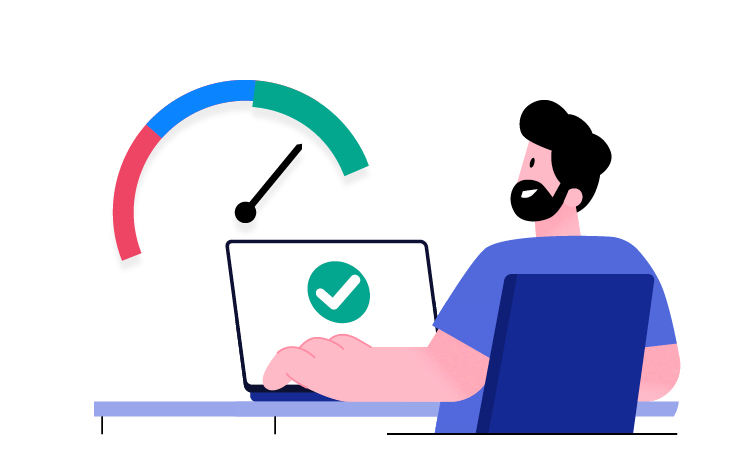Credit scoring as a risk assessment process for determining the probability that a borrower will repay their loan on time.
It is based on attributing points to customer characteristics reflecting both quantitative (mainly financial data) and qualitative elements (e.g. marital status, education level, etc.), including a thorough analysis of credit history as a key factor. Among the various credit scoring models, the FICO score stands out as a widely recognized model, crucial for its role in the credit scoring process, particularly in how it calculates credit scores based on factors such as payment history and credit utilization. This analysis considers the length of credit history and the impact of credit decisions on credit scores, emphasizing the importance of maintaining a good credit history to improve credit scores. It applies both to individual customers and enterprises (especially in the micro and SME segments).
Credit scoring history
The history of using scoring models in credit processes dates back to the Second World War. David Durand can be regarded as a precursor here. In 1941, in a project conducted for the US National Bureau of Economic Research, he studied the characteristics of ”good” and “bad” borrowers, including payment history as a crucial component. Payment history significantly impacts the scoring outcome, reflecting an individual’s ability to make on-time payments and manage debt effectively. In the following decades, this method became more and more popular, but the real breakthrough was the introduction of the US Equal Credit Opportunity Act in 1975, which prohibits discrimination against borrowers. Following the Equal Credit Opportunity Act, the introduction of VantageScore credit scores marked a significant evolution in credit scoring models, offering an alternative to FICO scores by considering different factors and data sources, which could lead to variations in scores. The risk assessment based on scoring models was ideally suited to the guidelines contained in the Act, ensuring full objectivity in the granting of increasingly popular credit products. Although at first scoring was used for the simplest products (credit cards), over time banks started to use this method also for cash loans, and later for mortgage loans. Currently, credit scoring is the most common method used for assessing the credit risk of individuals.
Good credit score
The scoring of a customer’s credit score in credit processes is usually based on a scorecard, which is fundamentally informed by the data found in the customer’s credit report. This report is the primary source of information for calculating credit scores, as it contains detailed records of credit habits and behaviors that significantly impact the score. It takes the form of a set of customer characteristics and corresponding attributes with assigned points. After analyzing all the characteristics, the individual points are summed up and constitute the final score. Within each scoring model, a cut-off point is also defined, which illustrates the border between “good” and “bad” borrowers. Achieving a higher credit score is pivotal as it opens the door to a plethora of benefits, including access to a wider array of credit products at more favorable interest rates. A higher credit score can significantly enhance loan terms, offering lower interest rates and even the possibility of 0% financing on cars and credit cards, which underscores the importance of striving for a higher credit score. However, the scale of points possible to obtain is often divided into credit score ranges, which makes it possible to maintain a separate approach to the customer depending on the level of estimated risk. These ranges are crucial in determining creditworthiness, as they influence loan approvals, interest rates, and access to credit products, emphasizing the importance of understanding the specific score range used by different creditors and scoring models.
However, the question is why specific characteristics are taken into account in a given scoring model and on what basis specific points are assigned to particular attributes. Building a model or a scorecard is not a trivial activity, as it requires expert knowledge of mathematics or statistics. Each bank has data on loans granted and their repayment. This data is divided into groups of ”good” and “bad” loans, and then within these groups sets of data are determined. Those sets will be used to build a scoring model, and to verify its effectiveness.

Credit report data
The scope of analyzed data depends on the type of information previously collected and archived by a given institution and the type of scoring used (application- or behavior-based). Using various statistical techniques or data mining, risk departments try to determine which parameters have a significant impact on the probability of a default. For years, logistic regression has been the most popular method used for building scoring models, but this area also uses decision trees, genetic algorithms, neural networks, and other AI or machine learning methods. Additionally, the integration of risk assessment tools such as decision trees and neural networks enhances the analysis of credit report data, employing techniques like risk matrix, failure modes and effects analysis (FMEA), and bowtie model to review and update assessments based on changing conditions. Therefore, specialist statistical software or data mining is most often used for creating scoring models.
Creating a scoring model and building a scorecard is the first stage in the full life cycle of this risk assessment method. Before it is fully utilized in credit processes, it is verified, most often under the Champion-Challenger approach, where the new model works alongside the current one and the metrics of effectiveness of both variants are checked. If the new model is more efficient, it becomes a Champion and is used for determining new customer risk. In order to streamline the scoring calculation process, credit processes most often use scoring engines, i.e. IT solutions based on business rules processing. Such systems also provide the ability to monitor the effectiveness and efficiency of scoring models implemented. This is important as the risk assessment should be adjusted to the current internal procedures of the bank and the general economic and demographic situation on a given market.
What is a credit risk assessment?
Credit risk assessment is the process of evaluating the creditworthiness of individuals, companies, or entities to determine the likelihood of default on a loan or debt obligation. It involves analyzing various factors such as financial stability, repayment history, credit score, income level, and debt-to-income ratio to assess the risk associated with extending credit to an individual or entity. A quantitative risk assessment method is often employed in this context, focusing on analytical and calculation-based approaches, such as annualized loss expectancy (ALE), to justify the cost of implementing countermeasures while also acknowledging its criticisms for potentially ignoring qualitative differences among risks.
The main goal of credit risk assessment is to estimate the risk of potential financial loss that a lender may face if a borrower fails to repay a loan or debt. By evaluating the credit risk of potential borrowers, lenders can make informed decisions about whether to approve a loan, set appropriate interest rates, or determine the amount of credit that can be extended.
Credit risk assessment plays a crucial role in the lending process, helping financial institutions, banks, and lenders manage risk effectively and make sound lending decisions. It allows lenders to balance the need to generate profits by granting loans with the need to mitigate the risk of defaults and minimize financial losses.
Credit scoring models software
Banks need to use efficient tools to best assess the creditworthiness of their customers and to reduce the risk of potential insolvency. Therefore, more and more often they use credit scoring software, which analyzes critical types of information like credit accounts, allowing for determining the risk of an undesirable event such as a defaulted loan. This software evaluates factors including credit card balances, emphasizing the importance of managing these balances for a favorable credit score. Such solutions are most often one of the key elements of the entire system infrastructure supporting the bank’s employees in the credit granting processes. Additionally, credit scoring models software aids in conducting thorough risk assessments by evaluating various factors like credit card balances and credit accounts, enhancing the bank's ability to identify and mitigate potential risks effectively.
Advantages of scoring tools:
- significant shortening of risk assessment processes and improvement of calculation efficiency. Creditworthiness assessment processes may be accelerated by as much as 75 per cent by selecting the appropriate software in the bank and ensure a multiple increase in loan sales.
- faster and more effective assessment of creditworthiness, minimizing the number of risky loans granted
- better efficiency with the same employment - credit scoring software allows to streamline credit processes without additional human resources, i.e. the need to hire additional employees
- automation of the credit assessment process, which also reduces the risk of human error and potential fraud
- integration with other systems provides the possibility of using a wide range of data but also allows to determine the scoring within different systems or business processes
- minimizing the risk of a wrong decision or granting a loan on conditions unfavorable to the bankcomprehensive credit policy management and its constant monitoring – all data and scoring calculations are performed and stored in one place.
- comprehensive credit policy management and its constant monitoring – all data and scoring calculations are performed and stored in one place.

Why is risk assessment important in credit analysis?
Risk assessment is crucial in credit analysis for several reasons:
- Mitigating Financial Losses: By assessing the risk associated with extending credit to individuals or entities, lenders can better predict the likelihood of default. This helps them allocate resources more efficiently and minimize potential financial losses.
- Maintaining Financial Stability: Effective risk assessment in credit analysis helps financial institutions maintain stability by identifying risky borrowers and loan portfolios. It allows lenders to take proactive measures to manage and mitigate risks before they escalate.
- Setting Interest Rates: Risk assessment plays a key role in determining appropriate interest rates for loans. Lenders can adjust interest rates based on the level of risk associated with a borrower, ensuring that they are compensated for the risk taken.
- Optimizing Loan Approvals: Credit risk assessment enables lenders to make informed decisions about approving loan applications. By evaluating the creditworthiness of borrowers, lenders can optimize the approval process and offer credit to those most likely to repay it.
- Regulatory Compliance: Financial institutions are required to comply with regulations that govern lending practices. Effective risk assessment ensures that lenders adhere to regulatory requirements, such as risk management standards and guidelines.
- Protecting Investor Interests: In cases where loans are bundled and sold as financial products, risk assessment is essential to protect the interests of investors. Accurate evaluation of credit risk helps investors make informed decisions about purchasing these financial products. Overall, risk assessment in credit analysis is essential for maintaining a healthy financial system, ensuring responsible lending practices, and safeguarding the interests of both lenders and borrowers. It allows financial institutions to make informed decisions, manage risks effectively, and contribute to overall financial stability.
Lates Posts
-

24 Jul 2024
Maximizing Potential Emerging From Open Banking Regulations in the MENavigate the changing landscape of open banking regulations in the Middle East and realise the full potential of financial development.
-

17 Jul 2024
What is Claims Management?Navigate the world of Claims Management with ease by accessing our website. Find valuable information and tools to streamline your insurance claims.
-

10 Jul 2024
Trends in the Insurance IndustryStay informed on the latest trends in the Insurance Industry with our comprehensive website. Explore insightful articles and analysis to stay ahead of the curve.
Tell us about your business needs. We will find the perfect solution.



